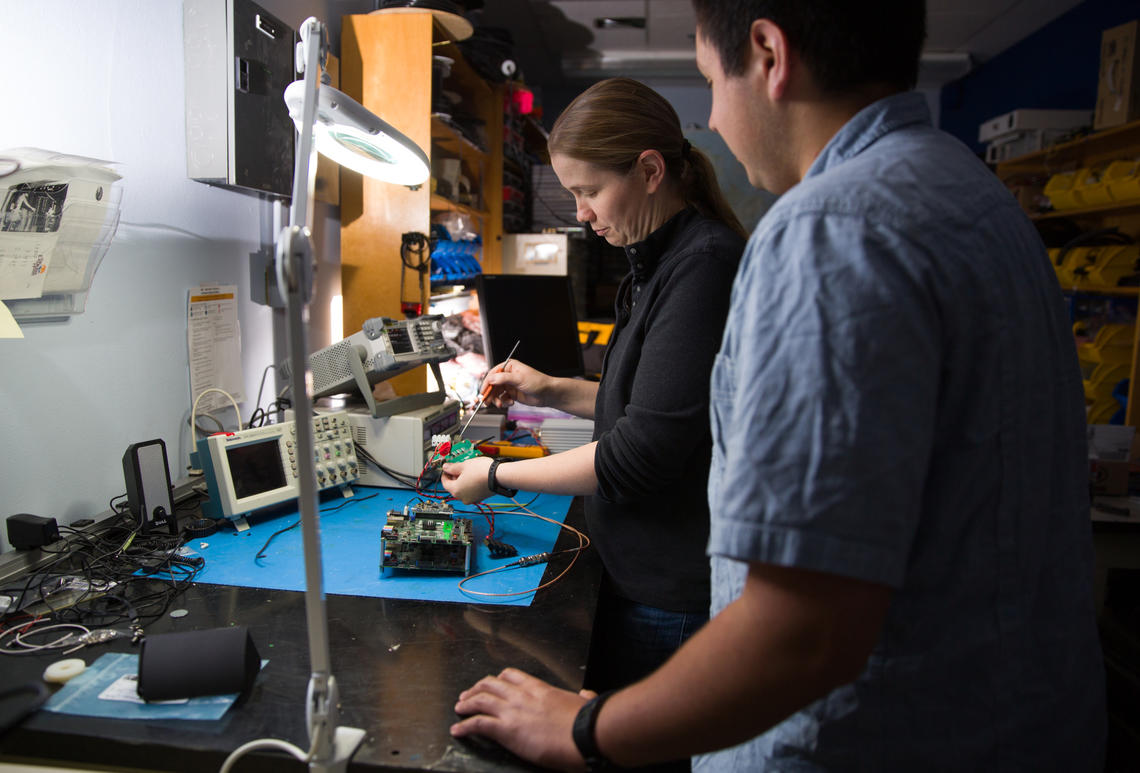Sept. 27, 2019
Summer job launched award-winning career in space physics

Emma Spanswick got “hooked” on space physics research in her third year as an undergraduate student in the Faculty of Science.
She got a summer job analyzing data from ground-based instruments operated by the University of Calgary’s world-leading Auroral Imaging Group, in the Department of Physics and Astronomy.
“I had a lot of fun with the data analysis side of auroral imaging. I’ve been hooked ever since,” says Dr. Spanswick, PhD.
She went on to do her master’s and PhD in space physics at UCalgary. Today, she is an assistant professor in the Department of Physics and Astronomy and co-director of the Auroral Imaging Group with colleague Dr. Eric Donovan, PhD, the professor who offered her the summer job that sparked her career.
This spring, Spanswick was awarded a Canada Research Chair in Geospace Dynamics and Space Plasma Physics.
Also earlier this year, UCalgary space physicists Spanswick, Donovan, Dr. David Knudsen, PhD (who focuses on spacecraft instruments to study electrodynamics and auroral physics), and five other current or former members of the Auroral Imaging Group received the prestigious Goddard Group Honor Award for Exceptional Achievement in Science from the U.S. National Aeronautics and Space Administration (NASA).
They shared the award with the Alberta Aurora Chasers citizens’ science group, Dr. Elizabeth MacDonald, PhD, from NASA’s Goddard Space Flight Center, and other Canadian and international scientists. The award is named for Robert H. Goddard, a pioneer of the U.S. space program.
The award recognizes the team’s work in discovering and scientifically confirming a new celestial phenomenon called STEVE, a violet-coloured, ribbon-like optical structure in the upper atmosphere that periodically appears in the night sky.
“Being part of the Goddard Award speaks to the University of Calgary’s world leadership in auroral imaging,” Spanswick says.
Researchers from the Physics and Astronomy pictured with their NASA awards.
Group operates state-of-the-art instruments
UCalgary’s Auroral Imaging Group develops and operates cutting-edge, ground-based instruments and data systems for observing large-scale space plasma phenomena in Earth’s near-space environment. “We use the upper atmosphere essentially as an imaging tool to look at space,” Spanswsick says.
Their instruments observe both the optical aurora that people see and the high-energy aurora that’s detected with radio wave propagation effects using radio instruments.
The multidisciplinary group at any given time consists of 16 to 25 people, including space physicists, computer scientists, engineers, scientists from other fields and “lots of students involved,” Spanswick says.
Undergrad engineering students are hired through the Schulich School of Engineering’s internship program. They work for 16 months on developing instrumentation and real-time communications protocols required for operating the group’s more than 100 remote-sensing instruments in northern Canada.
“We do the conceptual design of the instrumentation, get it funded, prototype it, build it, deploy it, and then use it for the science,” Spanswick says. “Then we use that science in turn to drive the next generation of instrumentation.”
Spanswick says the Auroral Imaging Group plans to also start hiring students in the Faculty of Science’s new internship program, which starts in fall of 2020.

The Auroral Imaging Group develops cutting-edge equipment for observing the aurora borealis.
Learning more about 'space weather' a priority
The focus of Spanswick’s Canada Research Chair is to study high-energy particles in the near-space environment, as well as how such “space weather” in the upper atmosphere affects high-frequency (HF) radio communications often used in emergencies.
For example, airliners fly out of radar range when crossing the Atlantic Ocean, so crews rely on HF radio to report aircraft positions. However, in severe space weather events the solar wind pushes highly energized particles into the upper atmosphere, changing its dynamics. HF radio waves can disappear, instead of bouncing off and being relayed — knocking out communications.
Spanswick is working with researchers at Merrimack College near Boston, Massachusetts, to develop instruments that would help specify space weather’s impacts in real time on the HF environment in the North. This would enable the airline, shipping, telecommunications, other industries and emergency responders to make more informed decisions. The work also involves collaboration with Natural Resources Canada and colleagues in UCalgary’s Department of Geomatics Engineering.
In August, Spanswick received a John R. Evans Leaders Fund award from the Canada Foundation for Innovation to replace the Auroral Imaging Group’s 11 radio instruments in northern Canada with next-generation instrumentation. The group also will install five new instruments across Greenland’s west coast, boosting the ability to observe space weather occurring along airliners’ transatlantic flight paths.
Spanswick also is deputy principal investigator (Donovan is the PI) of the ultraviolet aurora imaging instrument for the SMILE mission, jointly led by the European Space Agency and the Chinese Academy of Sciences. Planned for launch in 2023 with four instruments, SMILE aims to build a more complete understanding of the sun-Earth connection by measuring the solar wind and its dynamic interaction with the magnetosphere.
The UV aurora imager will produce continuous, high-resolution images of the UV aurora which encircles the Earth but isn’t visible because the sky is so bright. “For the first time, we’ll be able to follow the full chain of events that show us how the UV aurora reacts to space weather,” Spanswick says.
UCalgary space physicists will be responsible for operating the UV aurora imager, including developing command protocols and simulators, and for processing and analyzing its data.
“All this newer instrumentation we are developing is important for the study of space weather, or ionospheric impacts, on space utilization technology,” Spanswick says.
Interested in this topic?
- Learn more about the work of Emma Spanswick and her colleagues on space weather and its impact on earth




